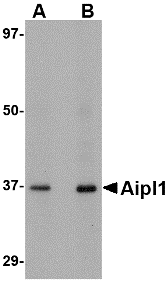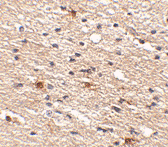Catalog# : 4853
Aipl1 was initially identified as a protein implicated in Leber congenital amaurosis (LCA), an autosomal recessive disorder thought to be caused by the abnormal development of photoreceptors. Aipl1 is a tetratricopeptide repeat protein that is highly homologous to ARA9, a protein involved in the HSP90-mediated nuclear translocation and transactivation of the aryl hydrocarbon receptor. Aipl1 has also been found to function as part of a chaperone heterocomplex, interacting with Hsp90 and Hsp70. Aipl1 also associates with the cell cycle regulator NUB1. It is thought that Aipl1 cooperates with Hsp70 but not Hsp90 to suppress the formation of NUB1 inclusions, and these interactions are necessary in the normal photoreceptor maturation, as mutations that lead to LCA also compromise the interactions with the Hsp chaperones. At least three isoforms of Aipl1 are known to exist.
Additional Names : Aipl1 (CT), Aryl hydrocarbon receptor interacting protein-like 1, LCA4
 Description
DescriptionLeft: Western blot analysis of Aipl1 in human brain tissue lysate with Aipl1 antibody at (A) 1 and (B) 2 µg/ml.
Below: Immunohistochemistry of Aipl1 in human brain tissue with Aipl1 antibody at 2.5 µg/ml.
Other Product Images

Source : Aipl1 antibody was raised against a 17 amino acid peptide near the carboxy terminus of the human Aipl1.
Purification : Affinity chromatography purified via peptide column
Clonality and Clone : This is a polyclonal antibody.
Host : Aipl1 antibody was raised in rabbit. Please use anti-rabbit secondary antibodies.
Application : Aipl1 antibody can be used for detection of Aipl1 by Western blot at 1 – 2 µg/ml.
Tested Application(s) : E, WB, IHC
Buffer : Antibody is supplied in PBS containing 0.02% sodium azide.
Blocking Peptide : Cat.No. 4853P - Aipl1 Peptide
Long-Term Storage : Aipl1 antibody can be stored at 4ºC, stable for one year. As with all antibodies care should be taken to avoid repeated freeze thaw cycles. Antibodies should not be exposed to prolonged high temperatures.
Positive Control
1. Cat. No. 1303 - Human Brain Tissue Lysate
Species Reactivity :H, M
GI Number : 74272276
Accession Number : NP_055151
Short Description : (CT) Aryl hydrocarbon receptor interacting protein-like 1
References
1. Sohocki MM, Brown SJ, Sullivan LS, et al. Mutations in a new photoreceptor-pineal gene on 17p cause Leber congenital amaurosis. Nat. Genet. 2000; 24:79-83.
2. Ma Q and Whitlock JP Jr. A novel cytoplasmic protein that interacts with the Ah receptor, contains tetratricopeptide repeat motifs, and augments the transcriptional response to 2,3,7,8-tetrachloro-dibenzo-p-dioxin. J. Biol. Chem. 1997; 272:8878-84.
3. Hidalgo-de-Quintana J, Evans RJ, Cheetham ME, et al. The Leber congenital amaurosis protein aipl1 functions as part of a chaperone complex. Invest. Ophthalmol. Vis. Sci. 2008; 49:2878-87.
4. Akey DT, Zhu X, Dyer M, et al. The inherited blindness associated protein Aipl1 interacts with the cell cycle regulator protein NUB1. Hum. Mol. Genet. 2002; 11:2723-33.

No comments:
Post a Comment